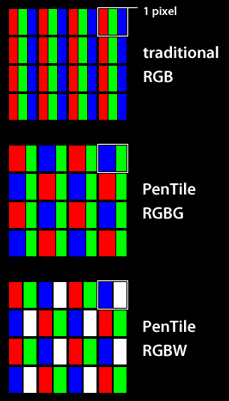PenTile

An special arrangement of sub-pixels on a digital full-color display that increases display power efficiency and/or pixel density compared to the traditional RGB sub-pixel arrangement.
Digital full-color displays produce an image using a grid of very small dots, called pixels. Each pixel consists of several sub-pixels of different primary colors, each of which can light up at a different brightness, visually blending together to produce the intended color at that part of the image.
In a traditional display, each pixel contains three sub-pixels: red, green, and blue. When all three are lit, the eye sees it as white. When all three are dark, the pixel is black. The other blends of red, green, and blue can produce any color of the rainbow at that pixel.
In a PenTile display, each pixel contains only two sub-pixels. Whichever of the three primary colors is missing in one pixel will be present in the next pixel over. Special software algorithms ensure that the overall image appears faithfully when viewed from a normal distance, even though not every pixel can produce every color on its own.
Some PenTile displays consist only of red, green, and blue sub-pixels. In these, there are twice as many green sub-pixels as red or blue, since the human eye is more responsive to green. These displays can achieve higher overall pixel density than RGB displays, since fewer sub-pixels are required per pixel.
Another kind of PenTile pattern - RGBW - adds a white sub-pixel, which increases the efficiency of an LCD display, improving the brightness of the display and/or the battery life of the device.
Both types of PenTile display produce a pattern that is not as smooth as RGB when viewed at very close distance. To some people this is bothersome, while others do not notice it. The effect varies depending on viewing distance and the image being displayed. The effect is also less noticeable at higher pixel densities (higher resolution per square inch.)
PenTile was originally developed by Clairvoyante, which was then acquired by Samsung. The technology is currently managed by Nouvoyance, in partnership with Samsung.









